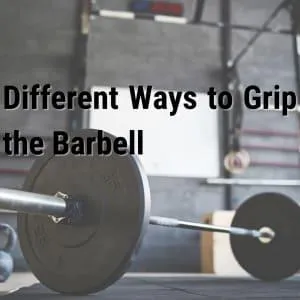WEIGHT LOSS & FITNESS BLOG

Different Ways to Grip the Barbell
Have you ever given any thought to the grip you use when lifting a barbell? Well if not, just know when gripping a barbell, there are a variety of grips that can be used for certain exercises and each one serves a purpose. Some will allow you to lift a little more weight, while some will put you in a stronger, stable position and maybe help you work around an injury. One thing we should strive for with each grip is to have a neutral wrist.
Check out the different styles of grips below and take note that the origin behind these grips begins from the anatomical position.
The pronated grip or “overhand” grip is going to be the most common grip used for pushing and pulling exercises. This grip is going to put the palms facing your body with the thumb wrapped around the bar and over the fingers. This grip allows you to create sufficient torque and set the shoulders in a stable position. A little tip, think about bending the bar when gripping it and you should feel the shoulders tighten up and lock-in.
The supinated grip or “underhand” grip is also a common grip, but cannot be used for all lifts. The grip is going to put the palms facing away from your body with the thumbs still wrapped around the bar and over the fingers. This grip is going to be used with mainly pulling exercises, such as barbell rows, curls, and chin-ups.
The neutral grip is going to be difficult to use without a specialty bar that provides multiple grips for that reason. This can be a favorable grip for people with shoulder issues, so usually, dumbbells are a good tool to use for this type of grip because of the freedom it allows. The palms are going to be facing each-other with the thumb still wrapped around the fingers. Like I said, without a specialty bar, this will more than likely not going to be an achievable grip on a standard barbell for most exercises.
The false grip or “suicide” grip is used with either the overhand or underhand grip where the thumb does not wrap around the barbell. This grip comes from the “gymnastic world” and would apply to the rings. This grip allows the athlete to move from under the rings to over the rings without too much deviation in the wrists. As far as barbell lifts, you can use a false grip on the overhead press because it can create a smoother bar path for the press. It can also be used for barbell rows and pull-ups, which will challenge your grip a little more. The barbell exercise I would not recommend using this grip with is the bench press, the last thing you want is 100lbs over your head and accidentally dropping it on yourself.
The mixed grip or alternate grip is a grip that will only apply to the deadlift. This grip will prevent the bar from rolling out of the hands and allow you to hold more weight for the lift. With that being said, it is helpful, but I do not recommend using it until you absolutely have to use it. The reason I don’t like people relying on the mixed grip all the time is that it does not allow you to properly set both shoulders, so for that reason, an increased risk of injury and possible muscle imbalance can occur. So, continue to use the overhand grip as your go-to grip for deadlifts and build that grip strength.
The hook grip is generally used for lifts that require pulling from the floor, such as the deadlift, clean, and snatch. This grip allows the bar to not roll out of your hand because you are locking in the thumb under your fingers, instead of over the top of your fingers. This grip can be challenging and somewhat uncomfortable if your fingers run on the short side. Overall, it will allow you to lift a little more weight if you can master it!
Remember, the stronger your grip is, the more weight you can generally use, which is a good thing. So take advantage when you can!
Coach Silas



Are you Ready to become
sTRONG - FIT - cONFIDENT?
Click the Button To Start Your Journey Today!!


